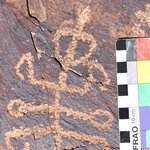Archaeology

Egyptian coffins and mummy cases have been found covered in a mysterious 'black goo'. What is this goo made from and what can it reveal about Egyptian funerary practice? The British Museum's Kate Fulcher has detailed answers but you can read a summary below.
Djedkhonsiu-ef-ankh died almost 3,000 years ago in ancient Egypt. He was a priest in the temple of Amun at Karnak, where he was an ‘Opener of the Doors of Heaven’ - permitted to open the temple sanctuary which contained the image of their deity.
An elite, Djedkhonsiu-ef-ankh was mummified and sewn into his plaster and linen mummy case,…

Evidence of prehistoric fluting techniques, using hammering or pressure to create a groove, has been found on the Arabian peninsula from 8,000 years ago.
Archeological finds are not new on the Arabian peninsula. There is evidence for lithics (stone tools) but evidence showed they were less advanced than northeast Africa or the Levant.
In Europe, the Levant and Africa, the Middle Paleolithic showed use of Levallois flaking methods, including predetermined forms of flaking products. Like spear tips, which gave hunters a big advantage in food. But new work also shows fluting, which was more…

(Inside Science) - An ancient bird statuette recovered from a refuse heap is the oldest known figurine discovered yet in China, shedding new light on how our ancestors created 3D art, a new study finds.
Scientists unearthed the miniature carving at the site of Lingjing in China, where previous excavations uncovered 11 layers each of distinct ages, ranging from 120,000 years ago to the Bronze Age. They discovered the artifact in a refuse heap left over from well diggers who removed most of the fifth layer in 1958. The location possesses a spring, which "may have attracted prehistoric…

Though slavery is still invoked in the United States of America, it is ironically because it was relatively rare compared to the rest of the continent. Only 4 percent of African slaves brought by Europeans and other Africans were brought to what is now the U.S, and importation was banned by President Thomas Jefferson in 1808. The remaining 96 percent went to Latin America and there is no benefit to invoking slavery when so many have not only slaves as ancestors, but also the colonizers who brought them.
Bringing in a huge population of slaves left behind a science story, and that story is…

The 5th century Mözs-Icsei dülő cemetery near Szekszárd in the area known as Pannonia dates back to the late Roman period.
Remains reveal the demographic makeup during the beginnings of Europe's Migration Period, when the Huns invaded Central Europe and the Romans retreated from modern-day Western Hungary as the empire collapsed in the face of barbarian hordes.
While that happened, Pannonia's population entered a period of continuous cultural transformation as new foreign groups arrived seeking refuge from the Huns, joining settlements already populated by remaining local Romanized…

A rock carving found in the Teymareh rock art site in Khomein county in Central Iran is part man and part mantis, with six limbs. Was it a mistake? The world's first graphic novel? A way to inspire warriors to fight their foes? We may never know. It's hard to even know its age.
Rock carvings - petroglyphs - of invertebrate animals are rare, so for a new paper entomologists teamed up with archaeologists to try and identify the motif. They compared the carving with others around the world and with the local six-legged creatures which its prehistoric artists could have encountered.…

Though the development of agriculture 10,000 years ago is what made humans the apex predator, a new analysis reveals that the stage was set long before farming became science.
Excavations at Border Cave in the Lebombo Mountains, on the border of KwaZulu-Natal Province, South Africa, and Swaziland, show that someone was cooking starchy Hypoxis angustifolia rhizomes plants, such as the Yellow Star flower, 170,000 years ago. It also suggests they probably used wooden sticks to extract plants from the ground.
Hypoxis angustifolia is evergreen, so it has visibility year-round, and since…

Navan Fort, the legendary capital of Ulster. has long been considered a site of ritual gatherings. Excavations have uncovered a huge 40-yard diameter building and a barbary ape cranium, likely from at least as far as Iberiam along with remnants of pigs, cattle and sheepfrom across Ireland, perhaps being reared as far afield as Galway, Donegal, Down, Tyrone and Antrim.
That means Iron Age communities were very mobile at holiday time, their own version of driving for Christmas.
The researchers used multi-isotope analysis on samples of tooth enamel to unlock the origins of each…

"Le Roman de la Rose" (The Romance of the Rose) was started in 1230 and completed around 1280. It is a medieval French poem styled as an allegorical dream vision and some parts that were later removed are quite steamy.
Its 22,000 lines describe the attempts of a courtier to woo his beloved. It was a medieval blockbuster, at least among the wealthy who could afford books, and a century later Geoffrey Chaucer, author of The Canterbury Tales, adopted and translated it for a new audience.
Now the oldest surviving pages, used as a folder or binding for other documents, have been revealed.…

In 1227, Genghis Khan, the founder of the Mongol Empire, died, leaving 129,000 soldiers to carry on his war of conquest. But they didn't do it in one unit, his sons and brothers were all given troops. One of the deceased sons, Jochi, had a son named Batu, and after all of his uncles died as well, Batu, founder of the Golden Horde in the western part of the empire, became the most feared Mongol of his generation.
As Temujin had done, Batu's diplomacy was the first salvo and it would be the last without arrows. When Genghis Khan demanded the extradition of a Khwarizm governor who had…